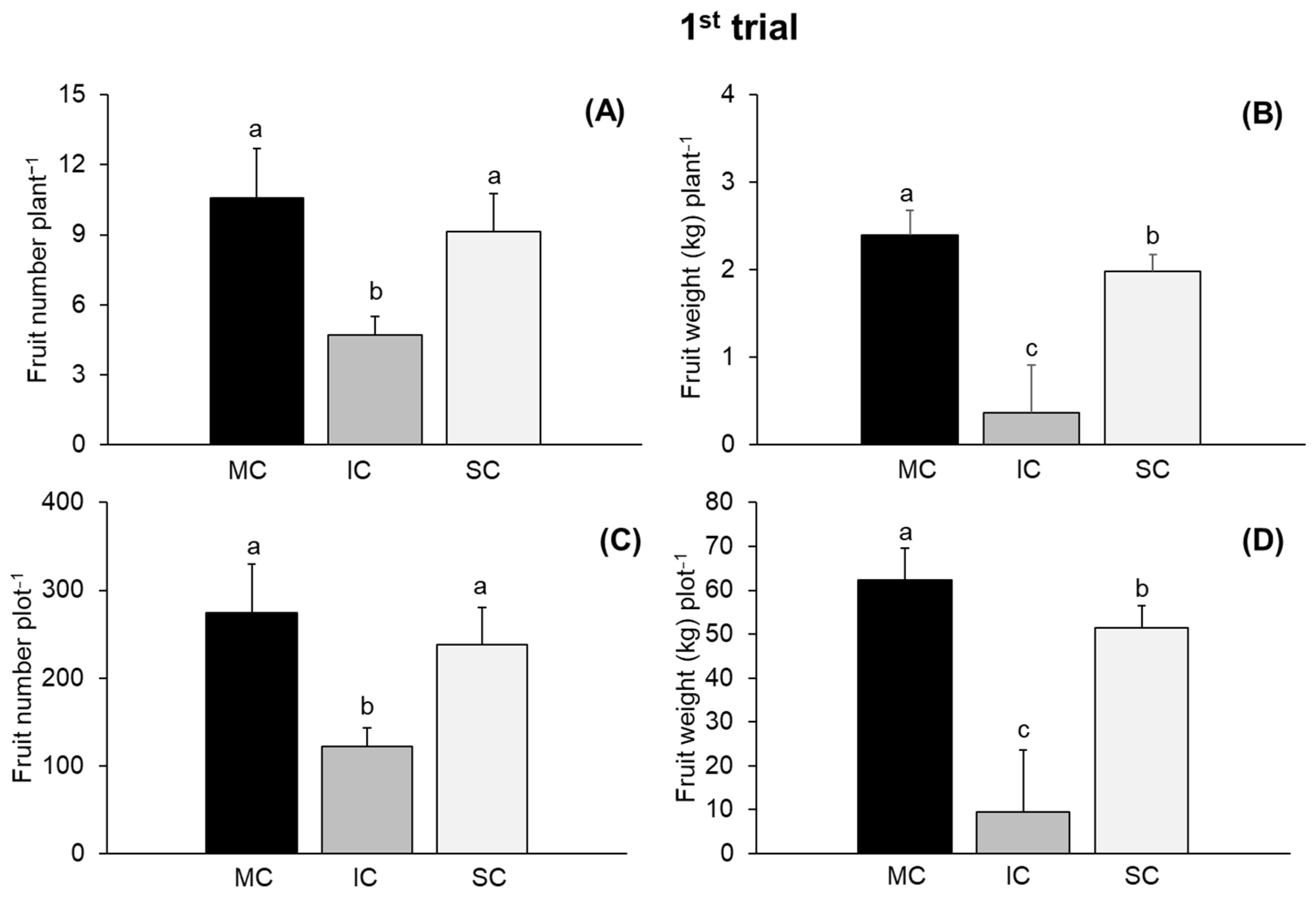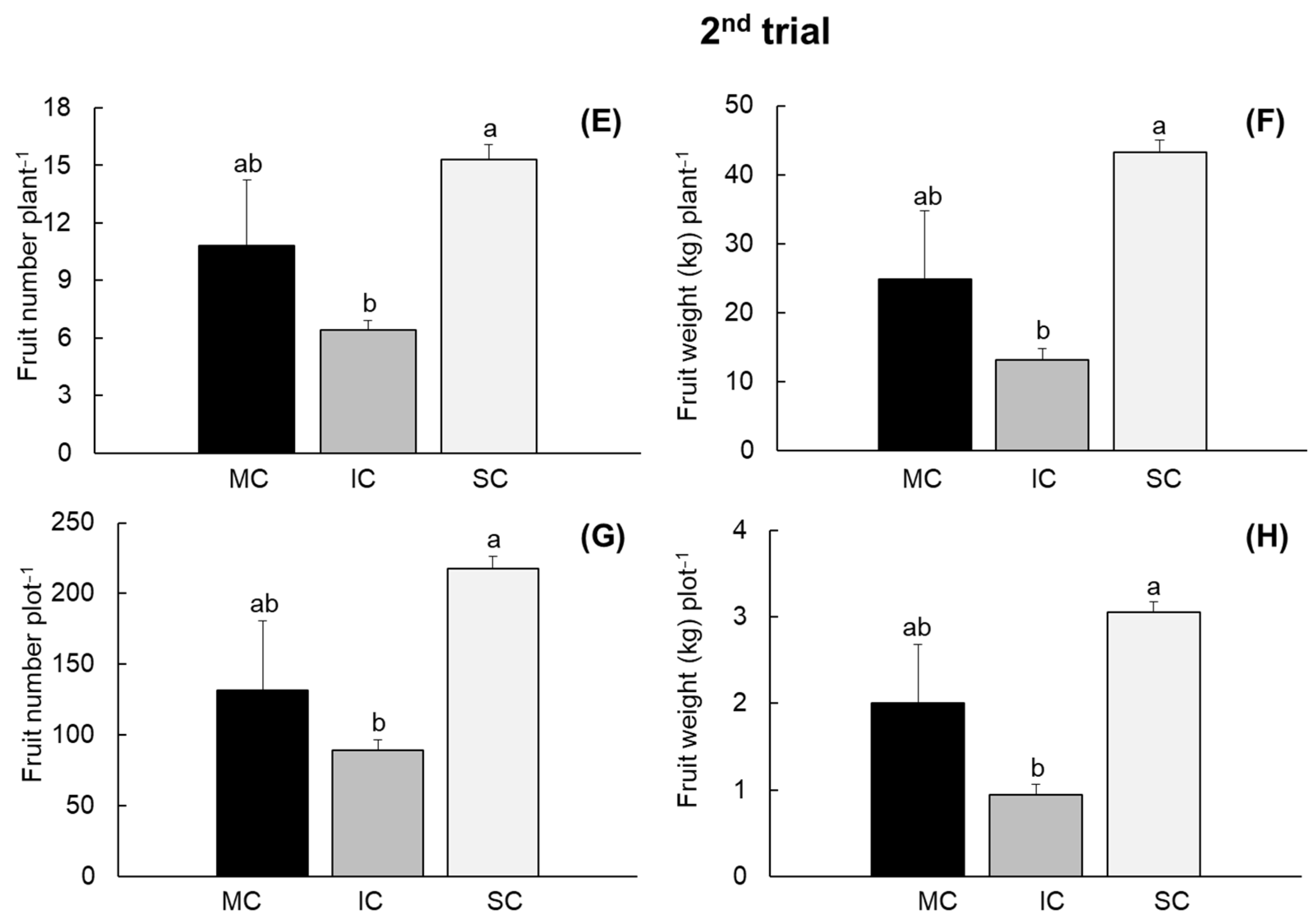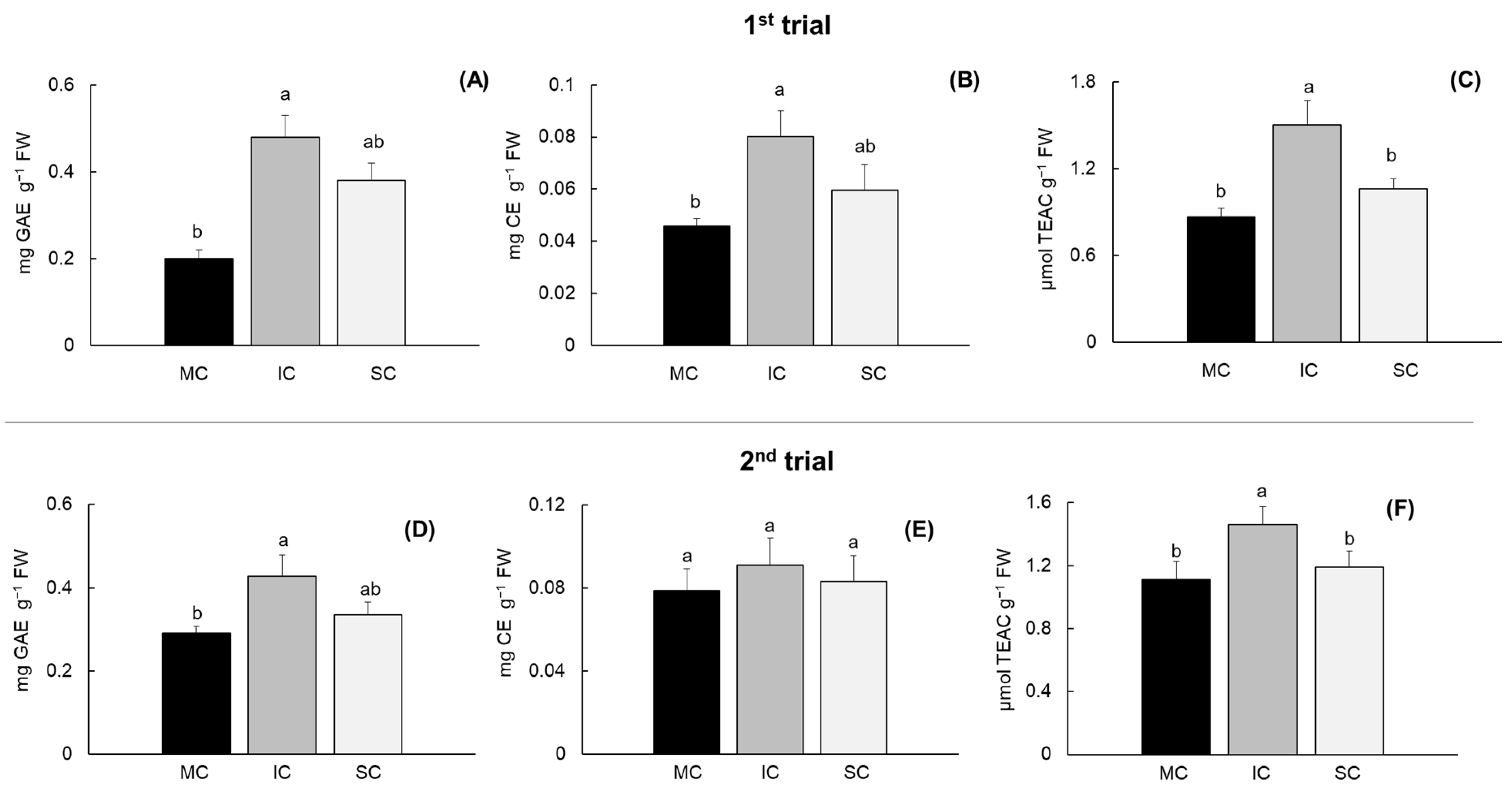Enhancing Tomato Productivity and Quality in Moderately Saline Soils through Salicornia-Assisted Cultivation Methods: A Comparative Study
Abstract
:1. Introduction
2. Materials and Methods
2.1. Materials
2.2. Plant Material, Experimental Design, and Sample Collection
2.3. Tomato Fruit Production and Quality
2.4. Extraction and Quantification of Total Phenolics and Flavonoids and Determination of Antioxidant Capacity
2.5. Extraction of Carotenoids and HPLC Analysis
2.6. Statistical Analysis
3. Results
3.1. Effect of Cultivation Method on Tomato Productivity
3.2. Effect of Cultivation Method on Commercial Quality of Tomatoes
3.3. Effect of Cultivation Method on Concentration of Phenolics and Flavonoids and Antioxidant Activity of Tomato Fruits
3.4. Effect of Cultivation Methods on the Carotenoid Profile and Content of Tomato Fruits
4. Discussion
5. Conclusions
Supplementary Materials
Author Contributions
Funding
Data Availability Statement
Acknowledgments
Conflicts of Interest
References
- Kang, Y.; Khan, S.; Ma, X. Climate Change Impacts on Crop Yield, Crop Water Productivity and Food Security—A Review. Prog. Nat. Sci. 2009, 19, 1665–1674. [Google Scholar] [CrossRef]
- Abd-Elmabod, S.K.; Muñoz-Rojas, M.; Jordán, A.; Anaya-Romero, M.; Phillips, J.D.; Laurence, J.; Zhang, Z.; Pereira, P.; Fleskens, L.; van der Ploeg, M.; et al. Climate Change Impacts on Agricultural Suitability and Yield Reduction in a Mediterranean Region. Geoderma 2020, 374, 114453. [Google Scholar] [CrossRef]
- Patel, D.; Saraf, M. Influence of Soil Ameliorants and Microflora on Induction of Antioxidant Enzymes and Growth Promotion of Jatropha curcas L. under Saline Condition. Eur. J. Soil Biol. 2013, 55, 47–54. [Google Scholar] [CrossRef]
- Corwin, D.L. Climate Change Impacts on Soil Salinity in Agricultural Areas. Eur. J. Soil Sci. 2021, 72, 842–862. [Google Scholar] [CrossRef]
- Litalien, A.; Zeeb, B. Curing the Earth: A Review of Anthropogenic Soil Salinization and Plant-Based Strategies for Sustainable Mitigation. Sci. Total Environ. 2020, 698, 134235. [Google Scholar] [CrossRef] [PubMed]
- Liang, J.; Shi, W. Cotton/Halophytes Intercropping Decreases Salt Accumulation and Improves Soil Physicochemical Properties and Crop Productivity in Saline-Alkali Soils under Mulched Drip Irrigation: A Three-Year Field Experiment. Field Crop. Res. 2021, 262, 108027. [Google Scholar] [CrossRef]
- Ben Hamed, K.; Castagna, A.; Ranieri, A.; García-Caparrós, P.; Santin, M.; Hernandez, J.A.; Espin, G.B. Halophyte Based Mediterranean Agriculture in the Contexts of Food Insecurity and Global Climate Change. Environ. Exp. Bot. 2021, 191, 104601. [Google Scholar] [CrossRef]
- Hasanuzzaman, M.; Nahar, K.; Alam, M.M.; Bhowmik, P.C.; Hossain, M.A.; Rahman, M.M.; Prasad, M.N.V.; Ozturk, M.; Fujita, M. Potential Use of Halophytes to Remediate Saline Soils. Biomed. Res. Int. 2014, 2014, 589341. [Google Scholar] [CrossRef] [PubMed]
- Santos, E.S.; Salazar, M.; Mendes, S.; Lopes, M.; Pacheco, J.; Marques, D. Rehabilitation of Abandoned Areas from a Mediterranean Nature Reserve by Salicornia Crop: Influence of the Salinity and Shading. Arid Land Res. Manag. 2017, 31, 29–45. [Google Scholar] [CrossRef]
- Mann, A.; Lata, C.; Kumar, N.; Kumar, A.; Kumar, A.; Sheoran, P. Halophytes as New Model Plant Species for Salt Tolerance Strategies. Front. Plant Sci. 2023, 14, 1137211. [Google Scholar] [CrossRef]
- Galli, F.; Rossi, A.; Raffo, P.; Merlani, G.; Venturi, F. Opportunities and Challenges in the Potential Food Uses of Edible Mediterranean Halophytes. Agrochimica 2023, 66, 259–276. [Google Scholar] [CrossRef]
- Rozema, J.; Schat, H. Salt Tolerance of Halophytes, Research Questions Reviewed in the Perspective of Saline Agriculture. Environ. Exp. Bot. 2013, 92, 83–95. [Google Scholar] [CrossRef]
- Rathore, A.P.; Chaudhary, D.R.; Jha, B. Assessing the Effects of Salicornia brachiata Roxb. Growth on Coastal Saline Soil Quality over Temporal and Spatial Scales. Appl. Soil Ecol. 2022, 169, 104196. [Google Scholar] [CrossRef]
- Khalilzadeh, R.; Pirzad, A.; Sepehr, E.; Khan, S.; Anwar, S. The Salicornia europaea Potential for Phytoremediation of Heavy Metals in the Soils under Different Times of Wastewater Irrigation in Northwestern Iran. Environ. Sci. Pollut. Res. 2021, 28, 47605–47618. [Google Scholar] [CrossRef] [PubMed]
- Cunha-Chiamolera, T.P.L.; Cecílio Filho, A.B.; Santos, D.M.M.; Chiamolera, F.M.; Guevara-González, R.G.; Nicola, S.; Urrestarazu, M. Lettuce in Monoculture or in Intercropping with Tomato Changes the Antioxidant Enzyme Activities, Nutrients and Growth of Lettuce. Horticulturae 2023, 9, 783. [Google Scholar] [CrossRef]
- FAOSTAT. Available online: https://www.fao.org/faostat/en/#data/QCL (accessed on 17 January 2024).
- Hanson, B.; May, D. Effect of Subsurface Drip Irrigation on Processing Tomato Yield, Water Table Depth, Soil Salinity, and Profitability. Agric. Water Manag. 2004, 68, 1–17. [Google Scholar] [CrossRef]
- Association of Official Analytical Chemists; Association of Official Agricultural Chemists. Official Methods of Analysis of the Association of Official Analytical Chemists; Association of Official Analytical Chemists: Rockville, MD, USA, 2000. [Google Scholar]
- Barragán-Iglesias, J.; Méndez-Lagunas, L.L.; Rodríguez-Ramírez, J. Ripeness Indexes and Physicochemical Changes of Papaya (Carica papaya L. Cv. Maradol) during Ripening on-Tree. Sci. Hortic. 2018, 236, 272–278. [Google Scholar] [CrossRef]
- Cortés, V.; Ortiz, C.; Aleixos, N.; Blasco, J.; Cubero, S.; Talens, P. A New Internal Quality Index for Mango and Its Prediction by External Visible and Near-Infrared Reflection Spectroscopy. Postharvest Biol. Technol. 2016, 118, 148–158. [Google Scholar] [CrossRef]
- Castagna, A.; Mariottini, G.; Gabriele, M.; Longo, V.; Souid, A.; Dauvergne, X.; Magné, C.; Foggi, G.; Conte, G.; Santin, M.; et al. Nutritional Composition and Bioactivity of Salicornia europaea L. Plants Grown in Monoculture or Intercropped with Tomato Plants in Salt-Affected Soils. Horticulturae 2022, 8, 828. [Google Scholar] [CrossRef]
- Borbalán, Á.M.A.; Zorro, L.; Guillén, D.A.; García Barroso, C. Study of the Polyphenol Content of Red and White Grape Varieties by Liquid Chromatography-Mass Spectrometry and Its Relationship to Antioxidant Power. J. Chromatogr. A 2003, 1012, 31–38. [Google Scholar] [CrossRef]
- Kim, D.O.; Chun, O.K.; Kim, Y.J.; Moon, H.Y.; Lee, C.Y. Quantification of Polyphenolics and Their Antioxidant Capacity in Fresh Plums. J. Agric. Food Chem. 2003, 51, 6509–6515. [Google Scholar] [CrossRef] [PubMed]
- Re, R.; Pellegrini, N.; Proteggente, A.; Pannala, A.; Yang, M.; Rice-Evans, C. Antioxidant Activity Applying an Improved Abts Radical Cation Decolorization Assay. Free Radic. Biol. Med. 1999, 26, 1231–1237. [Google Scholar] [CrossRef] [PubMed]
- Souid, A.; Giambastiani, L.; Castagna, A.; Santin, M.; Vivarelli, F.; Canistro, D.; Morosini, C.; Paolini, M.; Franchi, P.; Lucarini, M.; et al. Assessment of the Antioxidant and Hypolipidemic Properties of Salicornia europaea for the Prevention of TAFLD in Rats. Antioxidants 2024, 13, 596. [Google Scholar] [CrossRef] [PubMed]
- Kayikcioglu, H.H.; Duman, İ.; Asciogul, T.K.; Bozokalfa, M.K.; Elmacı, Ö.L. Effects of Tomato-Based Rotations with Diversified Pre-Planting on Soil Health in the Mediterranean Soils of Western Turkey. Agric. Ecosyst. Environ. 2020, 299, 106986. [Google Scholar] [CrossRef]
- Qasem, J.R. Nutrient accumulation by weeds and their associated vegetable crops. J. Hort. Sci. 1992, 67, 189–195. [Google Scholar] [CrossRef]
- Simpson, C.R.; Franco, J.G.; King, S.R.; Volder, A. Intercropping Halophytes to Mitigate Salinity Stress in Watermelon. Sustainability 2018, 10, 681. [Google Scholar] [CrossRef]
- Zuccarini, P. Ion Uptake by Halophytic Plants to Mitigate Saline Stress in Solanum lycopersicon L., and Different Effect of Soil and Water Salinity. Soil Water Res. 2008, 3, 62–73. [Google Scholar] [CrossRef]
- Jurado, C.; Díaz-Vivancos, P.; Gregorio, B.E.; Acosta-Motos, J.R.; Hernández, J.A. Effect of Halophyte-Based Management in Physiological and Biochemical Responses of Tomato Plants under Moderately Saline Greenhouse Conditions. Plant Physiol. Biochem. 2024, 206, 108228. [Google Scholar] [CrossRef] [PubMed]
- Colla, G.; Rouphael, Y.; Fallovo, C.; Cardarelli, M.; Graifenberg, A. Use of Salsola soda as a Companion Plant to Improve Greenhouse Pepper (Capsicum annuum) Performance under Saline Conditions. N. Z. J. Crop. Hortic. Sci. 2006, 34, 283–290. [Google Scholar] [CrossRef]
- Karakas, S.; Çullu, M.A.; Kaya, C.; Dikilitas, M. Halophytic Companion Plants Improve Growth and Physiological Parameters of Tomato Plants Grown under Salinity. Pak. J. Bot. 2016, 48, 21–28. [Google Scholar]




| Time (min) | Solvent A 1 (%) | Solvent B 2 (%) |
|---|---|---|
| 0 | 82 | 18 |
| 20 | 76 | 24 |
| 30 | 58 | 42 |
| 40 | 39 | 61 |
| 45 | 82 | 18 |
| Cultivation Method | ||||
|---|---|---|---|---|
| MC | IC | SC | ||
| 1st trial | Flesh firmness (N) | 3.82 ± 0.76 a | 3.64 ± 0.83 a | 4.18 ± 1.09 a |
| pH | 4.10 ± 0.06 a | 3.97 ± 0.08 a | 3.93 ± 0.06 a | |
| TSSC (% Brix) | 4.33 ± 0.80 b | 6.39 ± 1.62 a | 4.18 ± 0.52 b | |
| TA (g citric acid g−1 fresh fruit) | 0.26 ± 0.07 b | 0.38 ± 0.10 a | 0.25 ± 0.06 b | |
| TSSC/TA | 16.90 ± 3.03 a | 17.16 ± 2.31 a | 17.26 ± 3.80 a | |
| RPI | 3.11 ± 0.31 a | 3.03 ± 0.36 a | 3.18 ± 0.34 a | |
| 2nd trial | Flesh firmness (N) | 2.13 ± 0.22 a | 2.42 ± 0.14 a | 1.96 ± 0.10 a |
| pH | 4.11 ± 0.04 a | 3.97 ± 0.04 a | 4.13 ± 0.04 a | |
| TSSC (% Brix) | 4.40 ± 0.15 b | 6.02 ± 0.66 a | 4.35 ± 0.14 b | |
| TA (g citric acid g−1 fresh fruit) | 0.35 ± 0.04 b | 0.56 ± 0.09 a | 0.36 ± 0.01 b | |
| TSSC/TA | 13.29 ± 3.85 a | 11.51 ± 2.27 a | 12.45 ± 0.43 a | |
| RPI | 2.77 ± 0.20 a | 3.03 ± 0.11 a | 2.72 ± 0.09 a | |
| Carotenoid | Cultivation Method | |||
|---|---|---|---|---|
| MC | IC | SC | ||
| 1st trial | Phytoene | 40.15 ± 3.21 a | 29.69 ± 4.08 b | 27.29 ± 1.87 b |
| Phytofluene | 22.57 ± 5.99 a | 18.27 ± 3.86 b | 9.01 ± 0.52 c | |
| β-carotene | 20.54 ± 5.44 a | 18.61 ± 4.42 a | 17.23 ± 4.19 a | |
| Lycopene | 89.14 ± 10.15 b | 103.86 ± 13.12 a | 67.81 ± 8.44 c | |
| Total | 172.40 ± 12.62 a | 170.43 ± 15.70 a | 121.34 ± 9.40 b | |
| 2nd trial | Phytoene | 32.77 ± 1.76 a | 24.73 ± 5.38 b | 23.61 ± 0.73 b |
| Phytofluene | 18.51 ± 3.92 a | 14.11 ± 4.40 b | 7.39 ± 0.67 c | |
| β-carotene | 17.97 ± 4.49 a | 14.83 ± 3.94 a | 14.73 ± 3.68 a | |
| Lycopene | 77.16 ± 13.18 b | 95.98 ± 17.20 a | 51.48 ± 4.88 c | |
| Total | 145.47 ± 11.61 a | 149.33 ± 23.07 a | 97.54 ± 3.40 b | |
Disclaimer/Publisher’s Note: The statements, opinions and data contained in all publications are solely those of the individual author(s) and contributor(s) and not of MDPI and/or the editor(s). MDPI and/or the editor(s) disclaim responsibility for any injury to people or property resulting from any ideas, methods, instructions or products referred to in the content. |
© 2024 by the authors. Licensee MDPI, Basel, Switzerland. This article is an open access article distributed under the terms and conditions of the Creative Commons Attribution (CC BY) license (https://creativecommons.org/licenses/by/4.0/).
Share and Cite
Santin, M.; Parichanon, P.; Sciampagna, M.C.; Ranieri, A.; Castagna, A. Enhancing Tomato Productivity and Quality in Moderately Saline Soils through Salicornia-Assisted Cultivation Methods: A Comparative Study. Horticulturae 2024, 10, 655. https://doi.org/10.3390/horticulturae10060655
Santin M, Parichanon P, Sciampagna MC, Ranieri A, Castagna A. Enhancing Tomato Productivity and Quality in Moderately Saline Soils through Salicornia-Assisted Cultivation Methods: A Comparative Study. Horticulturae. 2024; 10(6):655. https://doi.org/10.3390/horticulturae10060655
Chicago/Turabian StyleSantin, Marco, Prangthip Parichanon, Maria Calogera Sciampagna, Annamaria Ranieri, and Antonella Castagna. 2024. "Enhancing Tomato Productivity and Quality in Moderately Saline Soils through Salicornia-Assisted Cultivation Methods: A Comparative Study" Horticulturae 10, no. 6: 655. https://doi.org/10.3390/horticulturae10060655
APA StyleSantin, M., Parichanon, P., Sciampagna, M. C., Ranieri, A., & Castagna, A. (2024). Enhancing Tomato Productivity and Quality in Moderately Saline Soils through Salicornia-Assisted Cultivation Methods: A Comparative Study. Horticulturae, 10(6), 655. https://doi.org/10.3390/horticulturae10060655







